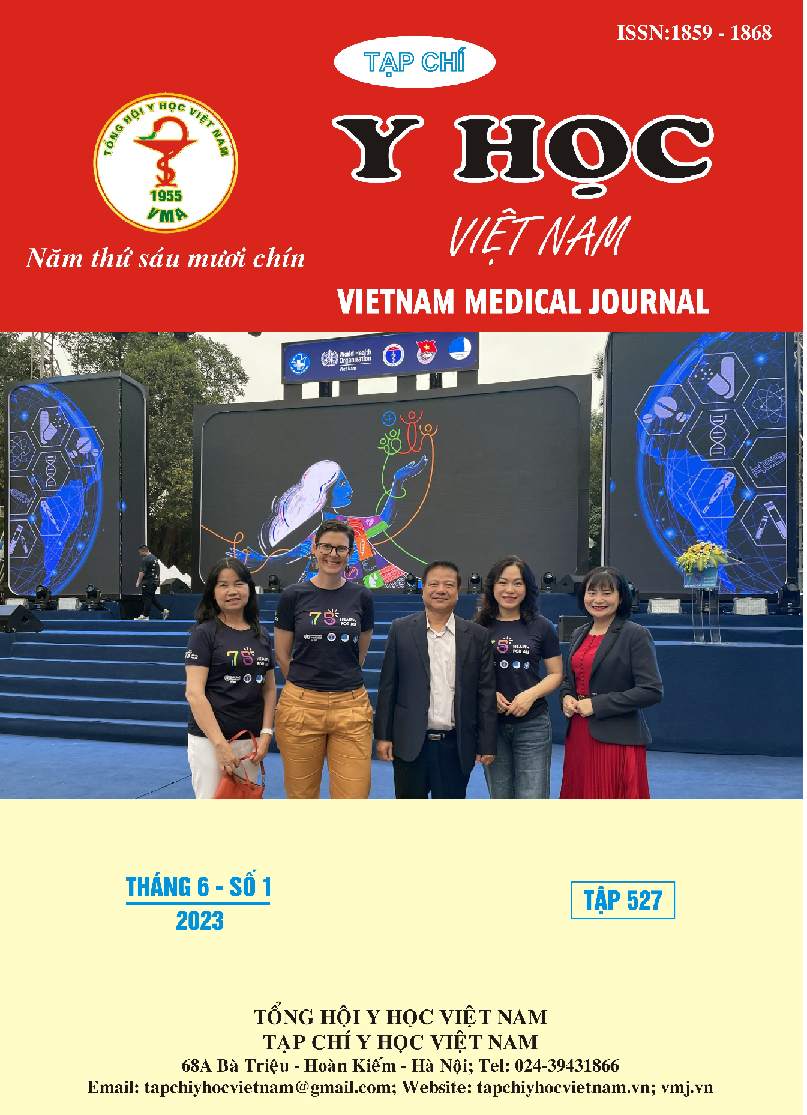ASSOCIATION BETWEEN LOCALIZATION OF FREE ABDOMINAL FLUID ON CT IMAGING AND POSTOPERATIVE SEPTIC COMPLICATIONS IN GASTROINTESTINAL PERFORATION
Main Article Content
Abstract
Objectives: The aim of this study is to investigate the association between the localizing distribution of abdominal ascites on computed tomography (CT) and the postoperative complications in patients with gastrointestinal perforation (GIP). Subjects and methods: a cross-sectional descriptive study of GIP undergoing abdominal CT for diagnosis and surgical treatment at Viet-Duc Friendship Hospital from July 2022 to June 2023. 120 GIP patients, consisting of 86 males and 34 females with an average age of 54.9 ± 16.68 years (ranging from 21 to 90 years). The perforated localization was found to be jejunum - ileum in 41 (34.2%) patients, stomach - duodenum 36 (30.0%), sigmoid colon - rectum 27 (22.5%), duodenum 6 (5.0%) and colon 10 (8.3%). Postoperative complications included 51 (42%) case with sepsis, 39 (32.5%) septic shock and 21 (17.5%) mortality within 30 days after surgery. Results: The risk of sepsis decreased sequentially according to the location of the free abdominal fluid from right upper quadrant (OR 5.7; 95% CI 2.6-12.5; p<0.01), right lower quadrant (OR 4.1; 95% CI) CI 1.9-8.9; p < 0.01), lower left quadrant (OR 2.3; 95% CI 1.1-5.1; p < 0.05), inter-loops (OR 2.5; 95%CI 1.2-5.4; p < 0.05). The odds of postoperative septic shock increased gradually according to the location of the fluid from pelvis (OR 2.8; 95% CI 1.3 - 6.3; p < 0.01), left lowerquadrant (OR 2.8; 95%CI 1.2 - 6.3; p < 0.01), left upper quadrant (OR 3.3; 95% CI 1.4 - 7.9; p < 0.01), inter-loops (OR 4.3; 95% CI 1.9 - 9.6; p < 0.05), lower right quadrant (OR 5.0; 95%CI 2.2 - 11.5; p < 0.01), upper right quadrant (OR 5.2; 95% CI 2.3 - 11.9; p < 0.01). The odds of mortality within 30 days increased according to the location of the fluid sequentially from right upper quadrant (OR 4.8; 95%CI 1.8-13.2; p < 0.01), right lower quadrant (OR 4.2; 95%CI 1.5-11.7; p < 0.01), inter-loops (OR 3.3; 95% CI 1.2-8.6; p = 0.01). Conclusion: The localization of free abdominal fluid on CT is associated with the risk of complications in patients after surgery for GIP.
Article Details
Keywords
gastrointestinal perforation, computed tomography, septic shock, clinical outcome
References
2. Bielecki K, Kamiński P, Klukowski M. Large bowel perforation: morbidity and mortality. Tech Coloproctol. Dec 2002;6(3):177-82. doi:10.1007/ s101510200039
3. Komatsu S, Shimomatsuya T, Nakajima M, et al. Prognostic factors and scoring system for survival in colonic perforation. Hepatogastroenterology. May-Jun 2005; 52 (63): 761-4.
4. Xu X, Dong HC, Yao Z, Zhao YZ. Risk factors for postoperative sepsis in patients with gastrointestinal perforation. World J Clin Cases. Feb 26 2020;8(4):670-678. doi:10.12998/ wjcc.v8.i4.670
5. Lee DB, Shin S, Yang CS. Patient outcomes and prognostic factors associated with colonic perforation surgery: a retrospective study. J Yeungnam Med Sci. Apr 2022;39(2):133-140. doi:10.12701/yujm.2021.01445
6. Singer M, Deutschman CS, Seymour CW, et al. The Third International Consensus Definitions for Sepsis and Septic Shock (Sepsis-3). JAMA. 2016;315(8):801-810. doi:10.1001/jama.2016.0287
7. Drakopoulos D, Arcon J, Freitag P, et al. Correlation of gastrointestinal perforation location and amount of free air and ascites on CT imaging. Abdom Radiol (NY). Oct 2021;46(10):4536-4547. doi:10.1007/s00261-021-03128-2
8. Shin R, Lee SM, Sohn B, et al. Predictors of Morbidity and Mortality After Surgery for Intestinal Perforation. Ann Coloproctol. Dec 2016; 32(6):221-227. doi:10.3393/ac.2016.32.6.221
9. Wu J, Shu P, He H, et al. Predictors of mortality in patients with acute small-bowel perforation transferred to ICU after emergency surgery: a single-centre retrospective cohort study. Gastroenterol Rep (Oxf). 2022;10:goab054. doi:10.1093/gastro/goab054
10. Bini R, Ronchetta C, Picotto S, et al. Importance of CT-scan predicting clinical outcomes in gastro-intestinal perforation. Ann Transl Med. Nov 2020;8(21):1421. doi:10.21037 /atm-20-2184


